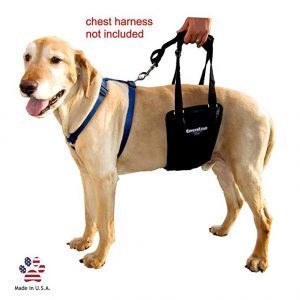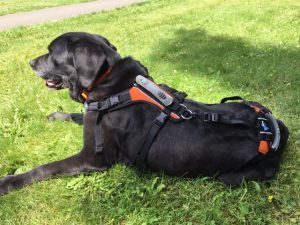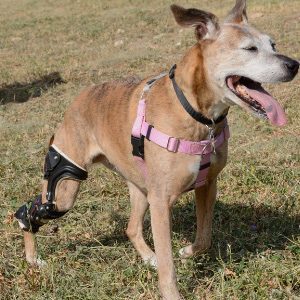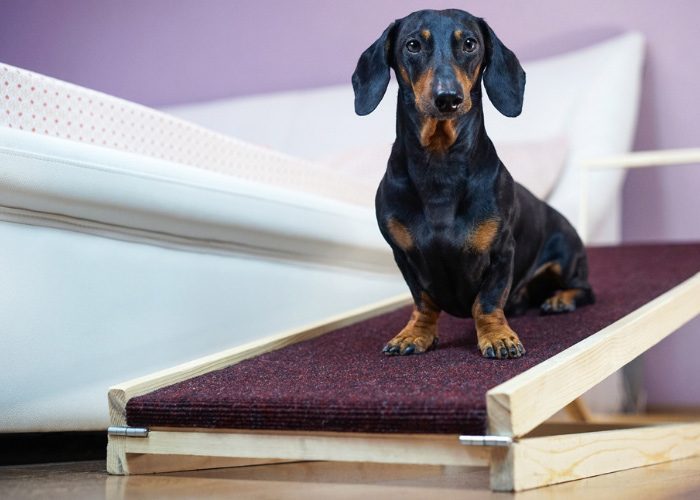Most dogs with arthritis will eventually need some form of assistive device to help them get around and do normal activities.
We have divided assistive devices into 7 categories:
- Stairs and ramps
- Slings and harnesses
- Support wraps and orthotics
- Strollers and wheelchairs
- Non-slip support
- Elevated feeding stations
- Bedding
STAIRS AND RAMPS
Jumping down from a bed or out of an SUV puts a lot of force on the joints and is not recommended for any dog—with or without arthritis! You can use stairs or ramps to help your dog, particularly when getting down/out. Many dogs will also benefit from assistance in getting up or jumping in.
1. Indoor “ladders”
(View indoor ladders and ramps)
There are many commercially available stairs and ramps designed to assist dogs in getting on and off the couch or bed. These come in all shapes, sizes, and décor. We have even seen very effective home-made ramps, such as using a cornhole lawn game with a yoga mat as a ramp!
When choosing couch and bed ladders, it is important to pick a product that has a non-slip surface and is wide enough for your dog to feel secure that they won’t fall off, and sturdy enough for the size of your dog. There is currently not a single product that CARE endorses, but we will be testing several different products in the future and will provide an update with recommended products.
Until then, if you have a favorite pet stairs/ ramp, please let us know!
2. Car “ladders”
There are a variety of products designed to help dogs get in and out of the car. These range from foldable plastic ramps to swivel steps that attach to a toe hitch, and many versions of steps and ramps in between. Unfortunately, we have not found any of these that work particularly well for all dogs.
As with the indoor ladders, car ramps or stairs must be wide enough for your dog to feel secure walking up and down. They must also not be too steep. Wide, gently-inclined, sturdy, slip-resistant ramps or stairs are difficult to produce without being too heavy or expensive.
Some of the most effective ramps we have seen are custom or home-made. Even though the perfect ramp does not yet exist, we still do believe that using some form of ramp or step, potentially with the help of a harness or sling (see below), is very important for assisting dogs when getting out of an SUV or truck.
Typically the biggest challenge with indoor or outdoor stairs or ramps is getting your dog to use them! This will take some training, just like any new behavior.
SLINGS AND HARNESSES
 There are two brands that we hands-down recommend, depending on the need.
There are two brands that we hands-down recommend, depending on the need.
Sling: If a dog is recovering from surgery or needs a sling to help navigate stairs, we recommend the Ginger Lead. This is a very high-quality sling that is comfortable for the dog – and for you! The purpose of using a sling is to act as a safety net or provide some gentle support.
While other products, including bath towels or sheets, can be used, if the sling will be needed or used for an extended period of time, it may be worth investing in the Ginger Lead.
 Support Harness: There is no other way to say it, the Help ‘Em Up Harness (pictured, left) is the best tool out there for dogs that well, need help getting up.
Support Harness: There is no other way to say it, the Help ‘Em Up Harness (pictured, left) is the best tool out there for dogs that well, need help getting up.
This is a two-piece harness that dogs can wear for extended periods of time. It is ergonomically designed with 2 handles for you to help your dog stand, walk, navigate stairs, or get in the car. The product is great quality and is designed to allow male and female dogs to easily go potty while wearing the harness.
You can purchase the harness online from the manufacturer: Help ‘Em Up Harness or many veterinary practices and rehabilitation clinics will carry the device and can help you with the fitting.
SUPPORT WRAPS AND ORTHOTICS
Wraps
Providing compression or support to an arthritic joint can potentially help ease pain and reduce swelling. This is particularly true for arthritis of the wrist and ankle. Neoprene carpal and tarsal wraps can be ordered from several manufacturers, including OrthoPets, Thera-Paw, and DogLeggs.
It is important to measure your dog to order the correct size; each manufacturer will have their own measurement guidelines. In some cases, a custom wrap may be indicated for the correct size or to provide the appropriate amount of support. In these cases, we have worked with Thera-Paw for many years and have found their products and service to be excellent.
We do not recommend supportive wraps for treating arthritis in any other joints as these would be unlikely to stay in place (leading to rubbing sores), unlikely to provide adequate compression, and would inappropriately restrict the range of motion.
However, Caldera makes wraps that are designed specifically to hold ice or heat packs over different body regions of dogs. This is a great tool to help with ice and compression therapy for your dog, but the wraps should not be worn when not used for applying ice or heat.
Orthotics (braces)
 Orthotics are devices that include hard, plastic material to provide support beyond that of a neoprene wrap. Orthotics are typically used to restrict the range of motion or provide support to hyper-mobile joints. We have used orthotics to manage carpal hyperextension injury, Achilles tendon injuries, and cranial cruciate ligament ruptures (though bracing is not typically our first recommendation for treating CCL rupture).
Orthotics are devices that include hard, plastic material to provide support beyond that of a neoprene wrap. Orthotics are typically used to restrict the range of motion or provide support to hyper-mobile joints. We have used orthotics to manage carpal hyperextension injury, Achilles tendon injuries, and cranial cruciate ligament ruptures (though bracing is not typically our first recommendation for treating CCL rupture).
Read more about dog knee braces, some of the pros and cons of using braces, what some leading veterinary experts think about braces, and how they can be part of joint pain management on Your Dog Advisor.
While there are some “off-the-shelf” braces commercially available, we generally do not recommend these as they are unlikely to fit the dog appropriately and unlikely to provide adequate support.
We recommend using custom-made orthotics. We have worked with OrthoPets for many years and found their products and customer service to be excellent. It is important to note that even the best custom-made orthotic will eventually cause rub sores and modifications of the device are often necessary.
STROLLERS AND WHEELCHAIRS
Strollers
A few years ago, it may have looked strange to see someone pushing their dog around in what appeared to be a baby carriage. But these days, this is perfectly acceptable! Dogs that cannot go for long walks, due to arthritis or other medical conditions, can still enjoy outings with you when they are in a pet stroller or wagon.
Ideally, your dog would get out and go for short bursts of walks and then rest in the stroller if the outing is longer than they can handle.
Carts/Wheelchairs
Wheelchairs are typically used for dogs with neurologic conditions that result in paralysis or severe weakness. However, there may be cases in which dogs with arthritis would benefit from a wheelchair in order to allow them to go for walks without putting stress on their arthritic joints.
We do not recommend this unless it is a last resort, as we ideally want dogs to use their limbs in order to retain the joint range of motion and muscle strength.
NON-SLIP SUPPORT
Dogs with arthritis can really struggle to stand up on slick floors such as hardwood or tile. It is imperative to provide non-slip support for them in their home environment! Our preferred method of providing non-slip surface is using carpet or rugs (with non-slip pad) and/or yoga mats or gym floor tiles.
There are several commercial products designed to be placed on the foot, pad, or toe of dogs to assist in traction. These include booties with treads, spray or pads applied to the paw pads to increase friction and bands placed around the toe-nails to help grip the floor.
Most dogs do not tolerate wearing booties or socks, so we do not recommend these products.
If carpets, rugs, and yoga mats are not an option, we recommend trying Dr. Buzby’s ToeGrips. However, our experience with these has been mixed; they have worked for some dogs while others did not tolerate the bands and/or improvement was not seen.
For dogs that do not tolerate their feet and nails being touched, these can be challenging to impossible to apply. Adhesive spray with granules, such as Paw Friction may have merit, though once the sprayed material is on the pads and a dog walks on a carpet, it will collect carpet fuzz and lead to further slipping on the hardwood floors. This product will also be challenging to apply to dogs with sensitive feet, and it requires reapplication about once a week (vs. ToeGrips that last 1-3 months).
ELEVATED FEEDING STATIONS
 Raising the food and water bowl can help dogs with arthritis. When eating from a bowl on the floor, dogs shift more weight to the front limbs. Dogs with carpal, elbow, shoulder and neck arthritis may have a difficult time reaching down to eat or drink. Dogs with pelvic limb arthritis already shift more weight to their front limbs, and then when eating they would further overload the front legs, potentially leading to compensatory muscle issues in the shoulder and neck.
Raising the food and water bowl can help dogs with arthritis. When eating from a bowl on the floor, dogs shift more weight to the front limbs. Dogs with carpal, elbow, shoulder and neck arthritis may have a difficult time reaching down to eat or drink. Dogs with pelvic limb arthritis already shift more weight to their front limbs, and then when eating they would further overload the front legs, potentially leading to compensatory muscle issues in the shoulder and neck.
Raising the bowl to the level that allows a neutral spine and minimal neck flexion will shift weight back on the pelvic limbs, which is actually a good form of exercise for dogs with pelvic limb arthritis (it’s a kind of isometric strengthening!). The ideal level of the food bowl is typically at about the dog’s shoulders.
There are many commercially available elevated feeders. This is the one we like, but there are many other options available.
BEDDING
All dogs deserve a warm, comfortable, safe place to rest. Many dogs sleep on their human’s bed, while others will sleep in their crate, and some will rest on the floor despite multiple bedding options!
The recommendations for dogs with arthritis are the following:
- Supportive bedding, such as memory foam mattresses, should be provided. We like this one
- Bedding should be placed in a warm/ non-drafty area of the house, and non-slick flooring should be under/ around the bed.
- If your dog is crate trained, the crate should be large enough for them to stand up, move around and stretch out; and the crate should have supportive bedding.
- If your dog is sleeping on your bed, ideally they should not be jumping off the bed but should use stairs or a ramp, particularly if the bed is high.
References
Greene LM, Marcellin-Little DJ, Lascelles BD. Association among exercise duration, lameness severity, and hip joint range of motion in Labrador Retrievers with hip dysplasia. J Am Vet Med Assoc 20213;242:1528-1533.
Levine D, Tragauer V, Millis DL. Percentage of normal weight-bearing during partial immersion at various depths in dogs. 2002; Proceedings of the 2nd International Symposium on Rehabilitation and Physical Therapy in Veterinary Medicine, Knoxville, Tenn.
Levine D, Marcellin-Little DJ, Millis DL, et al. Effects of partial immersion in water on vertical ground reaction forces and weight distribution in dogs. Am J Vet Res 2010; 71:1413-1416.

